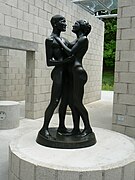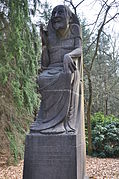Joseph Mendes da Costa
Joseph Mendes da Costa (born November 4, 1863 in Amsterdam , died July 20, 1939 in Amsterdam) was a Dutch sculptor.
Life
Joseph Mendes da Costa was born to Moses Mendes da Costa. Since his family was part of the Sephardic Jewish community in Amsterdam, Joseph has a Portuguese surname.
As a boy, Mendes da Costa worked as a stonemason in his father's workshop in Amsterdam. There he helped to make sinks and tombstones. From 1879 to 1881 he learned to draw at the newly founded School of Applied Arts Quellinus Amsterdam, and from 1882 to 1885 he sat in on modeling classes at the State University of Applied Arts Amsterdam in the morning hours. Here he met sculptors such as Lambertus Zijl (1866–1947), GW Dijsselhof (1866–1924) and Th. W. Nieuwenhuis (1866–1951).
Around 1887, Mendes partnered with Lambertus Zijl to make sculptures and handicraft products. From 1888 to 1901 he taught in the evenings at the company's industrial school for the working class. In 1911 or 1912 he moved to Laren . In 1914 he was offered a professorship at the Rijksakademie van beeldende kunsten , which he did not accept.
In 1925, Mendes da Costa moved from Laren back to Amsterdam. After his wife died in 1928, he led a secluded life. He was buried in the Portuguese-Jewish cemetery Beth Haim in Ouderkerk aan de Amstel .
Act
Mende's earliest works consist of sculptural scenes that he observed in his surroundings. In addition to these genre pieces, he mainly made utensils such as vases and saucers from glazed earthenware. He was not satisfied with the quality of this ceramic and built a new oven in his studio in 1889, in which the high temperatures required for the production of "Gres" could be reached. Gres is a ceramic between porcelain and earthenware, not porous and has a dense body. Mendes da Costa put a salt glaze on top of the glaze, which made the surface of the objects thicker and smoother. The forms of his more recent work have become narrower and more stylized than those of his earlier work.
Around 1900 he received his first major commissions for work on buildings. For the stock exchange ( Beurs van Berlage ) in Amsterdam, which were built between 1898 and 1903, he designed two chimney pieces and made wood carvings for desks and cupboards. Mendes da Costa was commissioned by the architects Alexander Kropholler (1881–1973) and Jan Frederik Staal to decorate both the exterior and the interior of a building for the life insurance company “De Utrecht” in Amsterdam. He was employed from 1903 to 1905. Kropholler also commissioned the decoration (sculptures and reliefs) of the "Martyrs of the Gorcumkerk".
As in his smaller works and bronze sculptures, Mendes da Costa also depicted many animals, especially monkeys and owls, in his monumental work. Because of these animal figures, he became Doctor Honoris Causa in 1914 in biology at the University of Groningen . He also made animal sculptures for a number of Kropholler churches.
From Ms. Kröller-Müller, to whom the Kröller-Müller Museum goes back and who received many orders from Mendes da Costa, he received the order for a memorial for General Christiaan de Wet and for a second memorial entitled “The Philosopher” (1922 –1924), also called "The Advisor" in the list of monuments in the Netherlands from the Second Boer War . It represents M.Th. Steyn , who was President of the Orange Free State from 1896 to 1902 . In this figure, Mendes da Costa wanted to symbolize the figure of a consultant in general. Ms. Kröller-Müller found the design unsuitable and decided not to accept it as a memorial for South Africa. Instead, Henry van de Velde received the order for a new monument in Steyn, which he executed in the abstract in 1924 in the form of a stone bench at the end of a square-shaped green area. The statue of Mendes da Costa is now in the Sint-Hubertus hunting lodge on the Hoge Veluwe, which belonged to the Kröller-Müller couple.
Work
Love (1917), Kröller-Müller Museum
Remarks
- ↑ Gorcumkerk is the usual name for the court church of Amsterdam.
- ↑ Christiaan de Wet .
- ↑ The Philosopher (1920–1924), Jachthuis Sint-Hubertus.
- ↑ De Bazel is a monumental brick building.
- ↑ Photographed in 1903 by Sigmund Löw (1845–1910).
Web links
- Mendes da Costa, CV , Dutch
- Mendes da Costa in the Drents Museum
| personal data | |
|---|---|
| SURNAME | Mendes da Costa, Joseph |
| BRIEF DESCRIPTION | Dutch sculptor |
| DATE OF BIRTH | November 4, 1863 |
| PLACE OF BIRTH | Amsterdam |
| DATE OF DEATH | July 20, 1939 |
| Place of death | Amsterdam |






